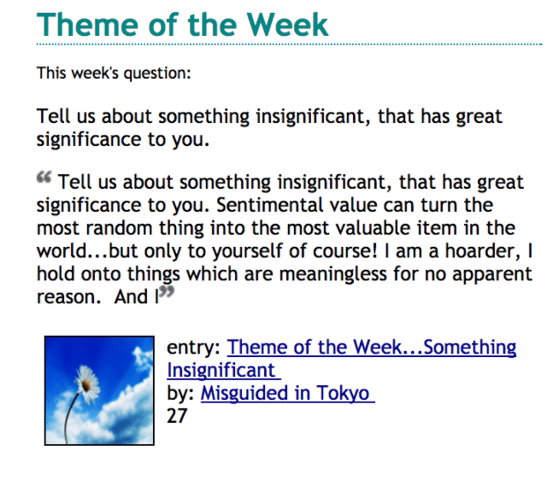Remember when blogging was new? I do. In fact, I remember hearing the word “blog” and thinking how funny it sounded. One of the first blogs that I remember was Open Diary. People used OD to share their lives online. In the late 90s, this was revolutionary and kind of mind blowing. Now, it’s downright quaint. Let's fast forward two decades and reassess what it takes to make your blog a successful one.
-1.png?width=640&name=Copy%20of%20NONPROFITS%20(6)-1.png)


Flashback to "Open Diary"
Now, blogging and content marketing are more popular than ever. To quote, Virginia Slims, “You’ve come a long way, baby.” Actually, we’ve all come a long way, together.

If you haven’t jumped on the blog bandwagon yet, here are some reasons why your organization should take the plunge.
- Websites with blogs have much more indexed content. Research compiled by HubSpot reports that website with blogs have 97% more inbound links. This means that more content is available for your audience to find. More content, typically means more indexed pages, which results in more visibility in the search results.
- People trust blog content. In fact, according to BlogHer, 81% of U.S. consumers trust information and advice from blogs.
- Blog content makes it easier to improve engagement with your audience.
However, we know it's not that easy. Blogging takes time and energy so it’s crucial that you get the very most out of it. After 20 years of helping clients through this process, and launching three blogs of our own, here's our strategy.
10 tips towards starting a successful blog
1. Develop personas so your writers “know” who they’re writing for. Say you sell dog food. Johnny, the new puppy owner would be coming to information on the best puppy food. Julia, the long-time dog owner who's already bought your product, just wants to know more about keeping her dog healthy as he ages. Always map your content to the Buyer's Cycle – learn more »
2. Before writing, determine what topics are important to your audience. If possible, use a keyword research tool such as SEMRush to find the best keywords to target. If that’s not possible, let Google Suggest help you out.
 Based on the screenshot above, if you're targeting Johnny in your next post, a popular topic for a blog post might be “what is the best dog food for puppies” as people are already searching for content regarding that topic.
Based on the screenshot above, if you're targeting Johnny in your next post, a popular topic for a blog post might be “what is the best dog food for puppies” as people are already searching for content regarding that topic.
3. Now that you’ve figured out what you’re going to write about, think about the audience persona you're targeting, and then hone in on the desired outcome you’d like the reader to take. Like most things, if you are deliberate, you’ll be more successful. In this example, you want Johnny to be convinced that your dog food is the best one available to him and for him to go to the purchase page.
4. Create a content draft. Your draft should include the overall objective of the piece. What are your goals? Is there any content that is required?
5. As you lay out your draft, be sure to include keywords your targeted persona might use to find your content. How can you weave the keywords into your post in a natural way? If you can’t do it, rethink your topic or keywords.
6. Find your writer. Does your content require a subject matter expert? Identify that person and schedule a time to discuss your project. If you're outsourcing, hand of your draft with the research you've done so far and save time in your publishing schedule to answer any of their questions. Not sure if outsourcing is a good choice? Review the pros and cons »
Down the road, if you have a few SME’s and writers you can trust, you can expedite this process a bit by using a tool like Trello. We have a few other content management tools we recommend »
7. Now that you have your topic, content draft and your designated writer, determine the approximate post length. How many words will it take you to convey the topic?
Clients often ask us how long is the “ideal” blog post? This is tricky because both have their advantages and disadvantages. Longer format blog posts (2000+ words) provide more keyword targeting opportunities. Longer posts also tend to generate more backlinks. But they come at a price: the main downside to long posts is that they take much longer to write.
Shorter posts allow you to frequently and regularly update your website. Not only does this save you time – Google likes fresh content and according to HubSpot, organizations that blog more than 20 times per month get five times the traffic than those who blog less than four times per month. With these considerations in mind, I recommend the blog length secret recipe – 8 short posts to every long post.
8. Use an SEO plugin to make sure you’ve properly optimized your post. We like the Yoast SEO Plugin. Yoast SEO makes it easy to select your target keyword and then make sure your title, description, headings, content, images and more all support that keyword.
9. Before publishing your blog post, make sure that Google Analytics is installed so you can accurate measure how your post is performing. Learn how to get started with Google Analytics with this ebook»
10. Create your publishing plan. You can use basic social media best practices or you could couple that with paid campaigns like with Facebook Ads. Be sure to spend at least as much time sharing and promoting your content as you do producing it, as even the most SEO-friendly post won't be found if it's not shared.
Blogging is one of the most effective ways to improve your organic visibility and traffic. If you’re committed to starting a blog, and ramping up your content strategy, follow these steps to ensure your time pays off.